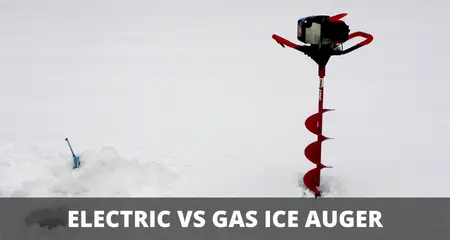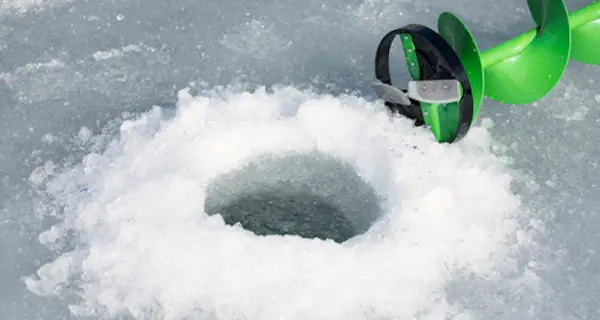Electric vs Gas Ice Auger (What Are The Pros And Cons?)
UPDATED 18 MAY 2023
by Robert Ceran
If you’re thinking about buying a new ice auger, the first thing you need to decide is what type is best for you.
Gas augers have been the mainstay of ice anglers for almost half a century, but in recent years electric augers have taken over the market, after they were first introduced about ten years ago.

So much so that electric ice augers are now the most common type of auger used on many lakes.
But what is the difference between these two types of ice augers, and what are the advantages and disadvantages of each?
In this article we’ll compare the pros and cons of gas vs electric ice augers, to help you choose the right one for your purpose.
Are electric ice augers better than gas powered ones?
Most ice anglers prefer electric ice augers over gas-powered ones since they are lighter, faster, and easier to use.
As a result of these advantages, electric augers have become the top selling models over the past years, and are now the most commonly used ice augers on many lakes.

However, keep in mind that electric augers aren’t as powerful as gas powered ones, and also drill fewer holes per charge.
So if you’re dealing with thick ice, or are planning to drill more than a hundred holes per day, then a gas ice auger might still be a better choice for you.
Related: Strikemaster 24v vs 40v electric ice auger
Pros and cons of electric ice augers
Let’s take a closer look at the key advantages and disadvantages of electric ice augers:
Pros:
- Lightweight (up to 50% lighter than gas augers)
- Easy to use
- Fast
- Quiet
- Can use reverse gear to clear slush out of an ice hole
Cons:
- More expensive than gas models
- Not as powerful
- Cold weather tends to drain their battery
One of the key advantages of electric ice augers such as Strikemaster or K-Drill is their lightness, since they are almost entirely built with composite plastics, which are very hard but lightweight.
And since portability is a key issue when it comes to ice fishing, this explains why many ice anglers prefer these lightweight models.
In addition to being lightweight, they also drill faster than gas-powered augers, and in combination, these two qualities make them more user friendly.
Another feature of electric ice augers is that they can be run in reverse, which is great for clearing slush from an ice hole (instead of having to scoop it out).
And if you get a model with a high quality lithium ion battery, one charge will last you almost as long as using a gas-powered model.
For example, the latest generation of 40V ion augers can drill 1000 inches of ice with one charge of their lithium batteries.
Finally, you can turn them on by pressing a switch, which is much easier than having to pull a starter cable repeatedly until the engine starts up.
This means you just have to remove the blade cover and hit the start button in order to begin drilling, and you can do this within a couple minutes of reaching your destination on the ice.
Pros and cons of gas ice augers

Now let’s also take a look the key advantages and disadvantages of gas ice augers:
Pros:
- More powerful than electric augers
- Can drill more holes with one tank
- Cheaper than electric models
- More durable
Cons:
- Heavy
- Noisy
- Their gas is smelly and flammable
Gas augers have been around for a long time, and as a result their technology has become more and more reliable over the years.
The key advantage of gas augers remains their ability to deliver more power and drill more holes, which is essential if you need to drill a lot of holes per day.
Also, some of their previous disadvantages have now been taken care of. For example, in the past you had to mix gas and oil when refueling them, but now you can get pre-mixed gas and oil combinations, which are much easier to use.
Another problem of gas augers is that their fuel is smelly and flammable, which is especially problematic inside the confined space of an ice shelter.
If you’re planning to use your gas auger inside a shelter, a better option would be a propane auger, which doesn’t produce noxious fumes.
Finally, a gas-powered model is more durable due to its simpler mechanics, with fewer moving parts that are thus less likely to break than an electronic device.
Do gas augers scare fish?
Gas augers can definitely scare fish if the ice is thin, or if you’re fishing in shallow water and the fish are pressured or finicky.
Two-stroke gas augers are the loudest, while four-stroke models are a little less noisy (but they can still spook fish).
A common strategy that helps to overcome this problem is to drill a bunch of holes first, and wait for at least thirty minutes before you start fishing through them. In many cases, this is enough time to allow spooked fish to return.
However, an even better way to avoid scaring the fish is by using an electric-powered ice auger, which is much less noisy.
In fact, I’ve found that I can start fishing right away after using a battery-powered auger, and don’t need to wait for fish to come back.
Which type of ice auger is best for you?
The ideal type of ice auger to use depends on the type of ice fishing you plan to do.
If you’re the kind of ice angler who drills a few holes inside your ice fishing house or shelter, and maybe a few more holes for tip-ups outside, then any kind of electric ice auger is probably the best choice for you.
However, if you like to do hole-hopping or ice trolling, where you’ll be drilling more than a hundred holes per day in search of fish, a gas auger would be a better choice for you.
The latter strategy is most often used on large lakes with little structure, such as Lake Winnipeg, where you have to cover a lot of ground in search of walleye.
Final remarks
This concludes our article on the pros and cons of using a gas or electric ice auger. Hopefully this will help you decide which one is right for you.
If you’re unsure which auger type is best for you, also check out our article on what kind of drill to use for an ice auger.
Tight lines & see you on the ice!
